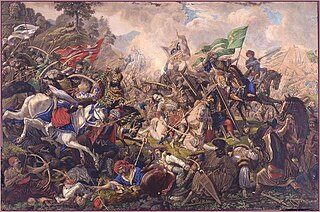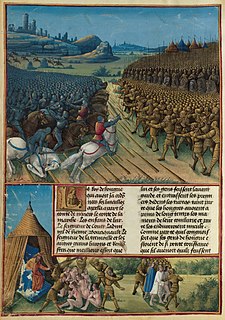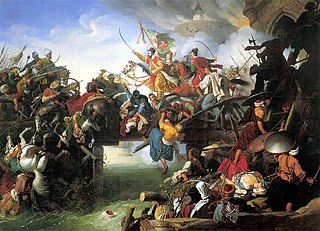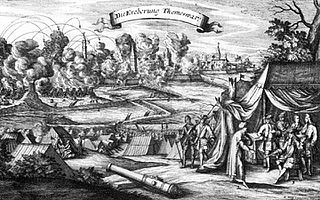 W
WThe Siege of Belgrade, Battle of Belgrade or Siege of Nándorfehérvár was a military blockade of Belgrade that occurred from July 4–22, 1456. After the fall of Constantinople in 1453, the Ottoman Sultan Mehmed the Conqueror rallied his resources in order to subjugate the Kingdom of Hungary. His immediate objective was the border fort of the town of Belgrade. John Hunyadi, the Count of Temes and captain-general of Hungary, who had fought many battles against the Turks in the previous two decades, prepared the defenses of the fortress.
 W
WThe Battle of Breadfield was the most tremendous conflict fought in Transylvania up to that time in the Ottoman–Hungarian Wars, taking place on October 13, 1479, on the Breadfield near the Saxon village of Alkenyér next to the Maros (Mureş) river. The Hungarian army was led by Pál Kinizsi, István Báthory, Vuk Branković, and Basarab Laiotă cel Bătrân.
 W
WIn the spring of 1684 an army of about 43,000 men marched under Charles V, Duke of Lorraine to capture the city of Buda from the Turks. After the main army crossed the Danube at Esztergom on 13 June, the front of the imperial army under the command of Maximilian Lorenz Starhemberg and the cavalry Gen. Louis William, Margrave of Baden-Baden arrived at the castle town of Visegrád on 15 June. On 16 June the town of Esztergom was taken by storm by imperial troops in spite of its strong walls, after a gate was destroyed by cannons. The majority of the Turkish occupation troops were killed and the city was plundered. Only a few Turks managed to withdraw to the castle on the rock above the city. After a siege of 1-1/2 days, the remaining Turkish garrison capitulated on 18 June.
 W
WThe Siege of Buda (1686) was fought between the Holy League and the Ottoman Empire, as part of the follow-up campaign in Hungary after the Battle of Vienna. The Holy League took Buda after a long siege.
 W
WThe Siege of Eger occurred during the 16th century Ottoman Wars in Europe. In 1552 the forces of the Ottoman Empire led by Kara Ahmed Pasha laid siege to the Castle of Eger, located in the northern part of the Kingdom of Hungary, but the defenders led by István Dobó repelled the attacks and defended the castle. The siege has become an emblem of national defense and patriotic heroism in Hungary.
 W
WThe Ottomans launched a siege of Eger, that lasted from September 20 to October 12, 1596, as part of the Long War, successfully conquering it after the 7,000 defenders of the fortress, mostly foreign mercenaries, were killed by the Ottoman forces commanded by the Sultan Mehmed III himself.
 W
WThe Siege of Kőszeg or in German sources: Siege of Güns was a siege of Kőszeg in the Kingdom of Hungary within the Habsburg Empire, that took place in 1532. In the siege, the defending forces of the Austrian Habsburg Monarchy under the leadership of Croatian Captain Nikola Jurišić, defended the small border fort of Kőszeg with only 700–800 Croatian soldiers, with no cannons and few guns. The defenders prevented the advance of the Ottoman army of over 100,000 toward Vienna, under the leadership of Sultan Suleiman the Magnificent and Pargalı Ibrahim Pasha.
 W
WThe Battle of Köbölkút was fought on August 5, 1663 as part of the Austro-Turkish War (1663–1664), between a Habsburg army and an Ottoman army under the command of Grand Vizier Köprülü Fazıl Ahmed. The battle took place near Köbölkút, Kingdom of Hungary and was an absolute Ottoman victory.
 W
WThe Second Battle of Kosovo was a land battle between a Hungarian-led Crusader army and the Ottoman Empire at Kosovo Polje. It was the culmination of a Hungarian offensive to avenge the defeat at Varna four years earlier.
 W
WThis page is partially a translation of the French version
 W
WThe Battle of Mohács was one of the most consequential battles in Central European history. It was fought on 29 August 1526 near Mohács, Kingdom of Hungary, between the forces of the Kingdom of Hungary and its allies, led by Louis II, and those of the Ottoman Empire, led by Suleiman the Magnificent. The Ottoman victory led to the partition of Hungary for several centuries between the Ottoman Empire, the Habsburg Monarchy, and the Principality of Transylvania. Further, the death of Louis II as he fled the battle marked the end of the Jagiellonian dynasty in Hungary and Bohemia, whose dynastic claims passed to the House of Habsburg. The Battle of Mohács marked the end of the Middle Ages in Hungary.
 W
WThe Battle of Nicopolis took place on 25 September 1396 and resulted in the rout of an allied crusader army of Hungarian, Croatian, Bulgarian, Wallachian, French, Burgundian, German, and assorted troops at the hands of an Ottoman force, raising the siege of the Danubian fortress of Nicopolis and leading to the end of the Second Bulgarian Empire. It is often referred to as the Crusade of Nicopolis as it was one of the last large-scale Crusades of the Middle Ages, together with the Crusade of Varna in 1443–1444.
 W
WThe Battle of Saint Gotthard (Hungarian: Szentgotthárdi csata; Turkish: Saint Gotthard Muharebesi; German: Schlacht bei Mogersdorf and Schlacht bei St. Gotthard; French: Bataille de Saint-Gothard; was fought on August 1, 1664 as part of the Austro-Turkish War, between the Imperial Army led by Generalleutnant Raimondo Montecuccoli, Jean de Coligny-Saligny, Wolfgang Julius, Count of Hohenlohe-Neuenstein, together with the Army of the Holy Roman Empire led by Reichsgeneralfeldmarschall Prince Leopold of Baden and Reichsgeneralfeldmarschalleutnant Georg Friedrich of Waldeck and the army of the Ottoman Empire under the command of Köprülü Fazıl Ahmed Paşa.
 W
WThe Siege of Szigetvár or the Battle of Szigeth was a siege of the fortress of Szigetvár, Kingdom of Hungary, that blocked Sultan Suleiman's line of advance towards Vienna in 1566. The battle was fought between the defending forces of the Habsburg Monarchy under the leadership of Nikola IV Zrinski, former Ban of Croatia, and the invading Ottoman army under the nominal command of Sultan Suleiman the Magnificent.
 W
WThe Siege of Temeşvar took place from 31 August to 12 October 1716 during the Austro-Turkish War. The Habsburg army led by Prince Eugene of Savoy, who had just won a crushing victory at Petrovaradin, managed to capture the fortress of Temeşvar an Ottoman stronghold since 1552, the capital of the Banat and the last Turkish stronghold in Hungary. The garrison capitulated after a 43 days siege. The city remained under military administration until 6 June 1778, when it was handed over to the administration of the Kingdom of Hungary.
 W
WThe Battle of Varna took place on 10 November 1444 near Varna in eastern Bulgaria. The Ottoman Army under Sultan Murad II defeated the Hungarian–Polish and Wallachian armies commanded by Władysław III of Poland, John Hunyadi and Mircea II of Wallachia. It was the final battle of the Crusade of Varna.